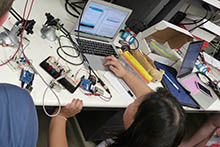Three years ago EE faculty undertook the first major redesign of the undergraduate curriculum. The structure of our new curriculum provides students with more flexibility so that they may complete their co-term earlier, earn a double major, or take courses outside of EE. Our redesigned curriculum also introduces application of EE fundamentals earlier in the undergraduate program; fosters the maker culture in EE education; and teaches all engineering students about basic EE tools. Reimagining the curriculum was a monumental undertaking; however, the popularity of our new courses and the enthusiastic response from students is evidence to our strong success. Check out our newest and most popular courses below!
An Intro to Making: What is EE? ENGR40M
Modern Physics for Engineers, EE65
Introduction to Matrix Methods, EE103
Networked Systems, EE107
Power Electronics, EE153

EE/CS Courses:
What Current EE Students Say...
Our students are a close-knit group. They enjoy the popular and innovative curriculum, the diverse and flexible nature of Electrical Engineering, and also being part of an outstanding university. More insights are available from our Spotlight profiles, featuring students, faculty, and alumni.
- Read EE's Spotlight Profiles by students just like you – Spotlight Profiles.
- Always Happening & New: EE Event Calendar









